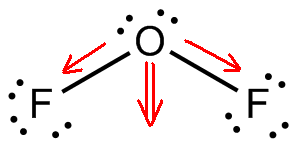
In the Lewis structure for the
(A)- 1
(B)- 2
(C)- 3
(D)- 4
Answer
498.9k+ views
Hint: The valence electrons remaining in the molecule, after the bond pairs have formed are the non-bonding electrons called the lone pair. In the central atom the lone pair along with the shard bond pair complete the octet.
Complete step by step answer:
- In the Lewis structure of
- The oxygen atom has six valence electrons with outer shell configuration
- Each of these atoms follows octet rule and tries to attain eight electrons in its outer shell having p-orbital by sharing electrons with the adjacent atoms forming a bond. So, the oxygen shares two of its electrons with the two fluorine atoms, one on each side. Then, out of the 20 electrons, four electrons are used up in the forming the two
The remaining 16 electrons form the non-bonding lone pairs of electrons. The fluorine having three lone-pairs

Therefore, from the Lewis structure it seen that in the central oxygen atom the number of lone pairs
So, the correct answer is “Option B”.
Note: This molecule is bent- shaped due to the two lone pairs of electrons on central atom, thereby preventing the cancellation of the charge on the adjacent fluorine atoms, which further attracts the bonding electrons towards itself due to higher electronegativity. Thus, it has a small dipole moment and forms polar molecules.
Complete step by step answer:
- In the Lewis structure of
- The oxygen atom has six valence electrons with outer shell configuration
- Each of these atoms follows octet rule and tries to attain eight electrons in its outer shell having p-orbital by sharing electrons with the adjacent atoms forming a bond. So, the oxygen shares two of its electrons with the two fluorine atoms, one on each side. Then, out of the 20 electrons, four electrons are used up in the forming the two
The remaining 16 electrons form the non-bonding lone pairs of electrons. The fluorine having three lone-pairs

Therefore, from the Lewis structure it seen that in the central oxygen atom the number of lone pairs
So, the correct answer is “Option B”.
Note: This molecule is bent- shaped due to the two lone pairs of electrons on central atom, thereby preventing the cancellation of the charge on the adjacent fluorine atoms, which further attracts the bonding electrons towards itself due to higher electronegativity. Thus, it has a small dipole moment and forms polar molecules.
Recently Updated Pages
Master Class 11 Business Studies: Engaging Questions & Answers for Success

Master Class 11 Accountancy: Engaging Questions & Answers for Success

Master Class 11 Computer Science: Engaging Questions & Answers for Success

Master Class 11 English: Engaging Questions & Answers for Success

Master Class 11 Social Science: Engaging Questions & Answers for Success

Master Class 11 Economics: Engaging Questions & Answers for Success

Trending doubts
Which one is a true fish A Jellyfish B Starfish C Dogfish class 11 biology CBSE

State and prove Bernoullis theorem class 11 physics CBSE

1 ton equals to A 100 kg B 1000 kg C 10 kg D 10000 class 11 physics CBSE

In which part of the body the blood is purified oxygenation class 11 biology CBSE

One Metric ton is equal to kg A 10000 B 1000 C 100 class 11 physics CBSE

Difference Between Prokaryotic Cells and Eukaryotic Cells




